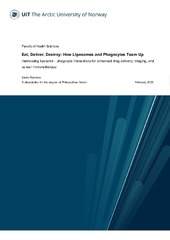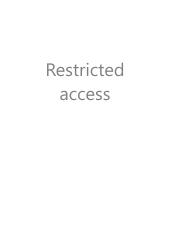| dc.contributor.advisor | Sundset, Rune | |
| dc.contributor.author | Markova, Elena | |
| dc.date.accessioned | 2025-05-15T12:38:56Z | |
| dc.date.available | 2025-05-15T12:38:56Z | |
| dc.date.embargoEndDate | 2026-06-04 | |
| dc.date.issued | 2025-06-04 | |
| dc.description.abstract | Cancer remains a major health challenge, with over 19.3 million new cases diagnosed in 2020. Conventional treatments like chemotherapy and radiation face limitations such as toxicity, resistance, and poor targeting. This thesis explores nanomedicine-based immunomodulation strategies, focusing on liposomes to enhance drug delivery to immune cells. Liposomes are nano-sized vesicles that encapsulate drugs for targeted delivery. However, their rapid clearance by the immune system limits their efficacy. Instead of avoiding immune interactions, we investigated how liposome design influences uptake by human phagocytes in whole blood. Monocytes showed the highest uptake of 200 nm liposomes, while neutrophils preferred larger ones. Surface modifications such as PEGylation reduced monocyte uptake, while sphingomyelin and gangliosides lowered overall phagocyte interaction. Conversely, peptides like cRGD and cFLFLF enhanced uptake, with cFLFLF liposomes activating neutrophils and increasing ROS production. Understanding these interactions allows for the refinement of liposome-based immunotherapy. We designed an immunomodulatory liposomal formulation incorporating nor-NOHA, an arginase inhibitor. Tumors suppress immune responses by depleting arginine via arginase 1 overexpression. Encapsulating nor-NOHA in liposomes helps restore immune function, enhancing anti-tumor responses. Our findings confirmed that liposomal nor-NOHA retains activity ex vivo, effectively inhibiting arginase 1. To optimize drug delivery, we explored real-time liposome tracking in vivo using copper-64 (⁶⁴Cu) radiolabeling and positron emission tomography. We tested three labeling strategies, with DSPE-NODAGA proving the most efficient, delivering 100% radiochemical yield in 5 minutes. This method enabled precise tracking of liposome distribution, circulation time, and tumor accumulation. Beyond cancer therapy, this work underscores the potential of leveraging immune-nanoparticle interactions for drug delivery. Rather than evading immune detection, embracing immune interactions can improve targeting and efficacy, paving the way for enhanced immunotherapies and personalized cancer treatments. | en_US |
| dc.description.abstract | Kreft forblir en stor helseutfordring, med over 19,3 millioner nye tilfeller diagnostisert i 2020. Konvensjonelle behandlinger som cellegift og stråling har begrensninger, inkludert toksisitet, resistens og dårlig målretting. Denne avhandlingen utforsker nanomedisinbaserte immunmoduleringsstrategier, med fokus på liposomer for å forbedre legemiddellevering til immunceller. Liposomer er nanoskopiske vesikler som kan kapsle inn medisiner for målrettet levering. Imidlertid fører deres raske eliminering av immunforsvaret til begrenset effekt. I stedet for å unngå immuninteraksjoner, undersøkte vi hvordan liposomdesign påvirker opptak av humane fagocytter i fullblod. Monocytter viste høyest opptak av 200 nm liposomer, mens nøytrofiler foretrakk større liposomer. Overflateendringer som PEGylering reduserte monocyttopptak, mens sfingomyelin og gangliosider senket fagocyttinteraksjonen generelt. Derimot økte peptider som cRGD og cFLFLF opptaket, hvor cFLFLF-liposomer aktiverte nøytrofiler og økte ROS-produksjonen. Innsikt i disse interaksjonene gjør det mulig å forbedre liposombasert immunterapi. Vi utviklet en immunmodulerende liposomal legemiddel som inneholder nor-NOHA, en arginasehemmer. Tumorer undertrykker immunresponsen ved å tømme arginin gjennom overuttrykk av arginase 1. Ved å kapsle inn nor-NOHA i liposomer kan vi gjenopprette immunfunksjonen og forsterke anti-tumorresponsen. Våre funn bekreftet at liposomal nor-NOHA beholder sin aktivitet ex vivo og effektivt hemmer arginase 1. For å optimalisere legemiddellevering undersøkte vi sanntidssporing av liposomer in vivo ved bruk av kobber-64 (<sup>64</sup>Cu) radiomerking og positronemisjonstomografi. Vi testet tre merkingsstrategier, hvor DSPE-NODAGA var mest effektiv, med 100 % radiokjemisk utbytte på 5 minutter. Denne metoden gjorde muglig presis sporing av liposomdistribusjon, sirkulasjonstid og opphopning i svulster. Utover kreftbehandling fremhever dette arbeidet potensialet i å utnytte interaksjoner mellom immunceller og nanopartikler for legemiddellevering. I stedet for å unngå immunforsvaret kan vi forbedre målretting og effekt ved å omfavne disse interaksjonene, noe som kan føre til bedre immunterapier og mer persontilpassede kreftbehandlinger. | en_US |
| dc.description.doctoraltype | ph.d. | en_US |
| dc.description.popularabstract | Cancer remains a major challenge, affecting millions worldwide. Traditional treatments like chemotherapy often harm healthy cells and face resistance from tumors. In this research, we explore tiny, drug-carrying particles called liposomes to improve cancer treatment by working with the immune system. Instead of avoiding immune cells, we designed liposomes that interact with them to enhance drug delivery.
We studied how different liposome designs affect their uptake by immune cells in the blood. By fine-tuning size and composition, we developed formulations that efficiently reach target cells. We also loaded liposomes with a molecule (nor-NOHA) that helps restore immune function by preventing tumors from suppressing the body's defenses.
Additionally, we created a method to track liposomes in the body using a radioactive marker, allowing real-time imaging of their distribution. This research paves the way for smarter, more precise cancer treatments that harness the immune system, offering hope for more effective and personalized therapies. | en_US |
| dc.description.sponsorship | This work was supported by Tromsø Forskningsstiftelse (19_PET-NUKL)/180◦N/Norwegian-Nuclear-Medicine-Consortium and the Norwegian Research Council (Grant nr: 314984, S. Hak/C.Wolowczyk). | en_US |
| dc.identifier.isbn | 978-82-350-0026-2 | |
| dc.identifier.uri | https://hdl.handle.net/10037/37092 | |
| dc.language.iso | eng | en_US |
| dc.publisher | UiT The Arctic University of Norway | en_US |
| dc.publisher | UiT Norges arktiske universitet | en_US |
| dc.relation.haspart | <p>Paper I: Giambelluca, M., Markova, E., Louet, C., Steinkjer, B., Sundset, R., Škalko-Basnet, N. & Hak, S. (2023). Liposomes - Human phagocytes interplay in whole blood: effect of liposome design. <i>Nanomedicine: Nanotechnology, Biology, and Medicine, 54</i>, 102712. Also available in Munin at <a href=https://hdl.handle.net/10037/32473>https://hdl.handle.net/10037/32473</a>.
<p>Paper II: Markova, E., Wolowczyk, C., Mohamed, A., Sofias, A.M., Martin-Armas, M., Sundset, R., Berndtsson, J., Hak, S. & Škalko-Basnet, N. (2025). Liposomal Nω-hydroxy-l-norarginine, a proof-of-concept: Arginase inhibitors can be incorporated in liposomes while retaining their therapeutic activity <i>ex vivo. European Journal of Pharmaceutical Sciences, 204</i>, 106959. Also available in Munin at <a href=https://hdl.handle.net/10037/37072>https://hdl.handle.net/10037/37072</a>.
<p>Paper III: Markova, E., Kranz, M., Karlsen, M., Wolowczyk, C., Anaya, A.S.M., Škalko-Basnet, N., … Hak, S. Fast, efficient, and simple liposome radiolabeling with <sup>64</sup>Cu and DSPE-NODAGA. (Manuscript). | en_US |
| dc.rights.accessRights | embargoedAccess | en_US |
| dc.rights.holder | Copyright 2025 The Author(s) | |
| dc.rights.uri | https://creativecommons.org/licenses/by/4.0 | en_US |
| dc.rights | Attribution 4.0 International (CC BY 4.0) | en_US |
| dc.subject | nanomedicine | en_US |
| dc.subject | liposomes | en_US |
| dc.subject | phagocytic immune cells | en_US |
| dc.subject | immunotherapy | en_US |
| dc.subject | cancer | en_US |
| dc.title | Eat, Deliver, Destroy: How Liposomes and Phagocytes Team Up. Harnessing liposome - phagocyte interactions for enhanced drug delivery, imaging, and cancer immunotherapy | en_US |
| dc.type | Doctoral thesis | en_US |
| dc.type | Doktorgradsavhandling | en_US |


 English
English norsk
norsk

